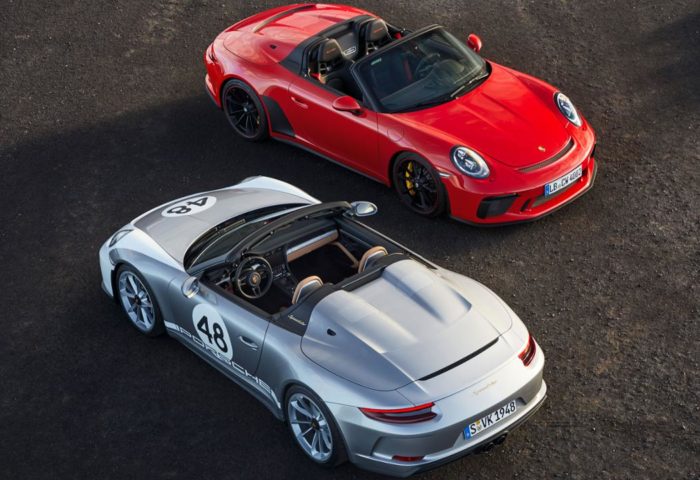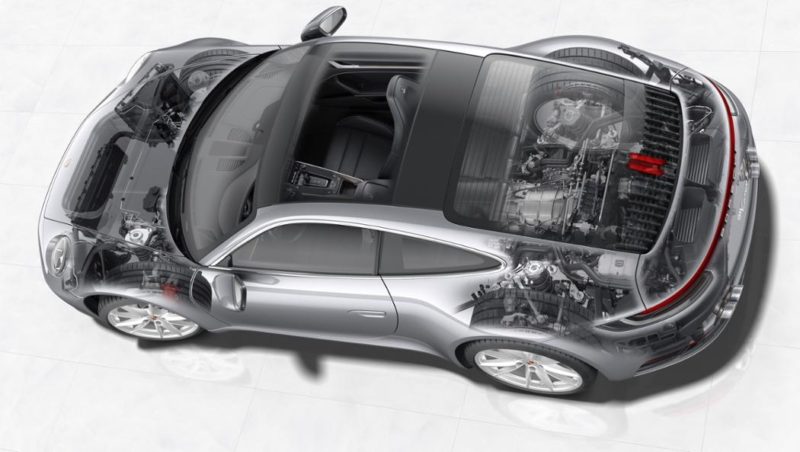How Will Porsche Engines Change with the Introduction of GPF Filters?
公開日:2019.05.22

Production of the 911 Speedster
The other day, when the news broke that “the new 911 Speedster has finally entered mass production,” my husband was unusually excited and exclaimed, “Wow!”
I asked him, “I think it’s great news that the Speedster is being produced, but is it really that big of a deal?”
He explained that from now on, cars sold in Europe will be equipped with GPF (Gasoline Particulate Filter), so there were concerns that “the 911 Speedster might have to suffer power loss or, worse, might not even be able to be produced and sold.”
In fact, BMW halted sales of the M3 in Europe, and the hypercar Mercedes-AMG planned to produce has been delayed. So, the fact that the Speedster has managed to clear these standards and enter production is truly an incredible achievement. Porsche must have worked extremely hard. That said, there are still concerns that adding the GPF might make the engine sound quieter or change its tone.
Curious about this GPF—something I’d only heard about in passing—I decided to do some research since it seemed like a significant issue.
EURO6 PN Regulations
Regulations on particulate emissions from gasoline vehicles began with EURO5 in 2009. Later, on September 1, 2014, the EU implemented EURO6, which set stricter limits on pollutants from vehicles. EURO6 particularly tightened restrictions on particulate matter (solid or liquid particles sized in micrometers, μm) and NOx (nitrogen oxides) emissions.
As a result, all new cars sold in the EU from January 1, 2015, onward must comply with EURO6 standards.
Then, from September 2017, an even stricter standard called “EURO6 d-TEMP” was introduced. Previously, regulations focused on the mass of particulate matter (PM), but now they also regulate the number of emitted particles (PN: Particulate Number). This change was necessary because,
mass-based limits don’t adequately reflect the presence of ultrafine particles that easily penetrate the human body and pose health risks, so regulating particle count became essential.
Thus, the PN regulation was established. Automakers now have to reduce particulate emissions from gasoline engines to one-tenth of the levels required under EURO5 in 2009.
*Source: CATALAR “GPF Catalyst”
The Emergence of GPF
Unlike PM mass regulations, PN (particle number) regulations require controlling the number of ultrafine particulate emissions. The filter that accomplishes this is the ‘GPF (Gasoline Particulate Filter),’ which captures particulate matter emitted from the engine.
According to a December 2018 automotive media article, the GPF weighs about 7 kg each, and Porsche equips one filter for 4-cylinder engines and two filters for 6- and 8-cylinder engines.
*Source: FORZA STYLE “Cars Are Also Concerned About Weight” Analyzing Porsche’s New T Models!
Because of the need to install GPFs, sports cars now require even more advanced weight-saving technologies, and development costs have soared. Many manufacturers have had to discontinue sports models or accept power reductions.
Wow, that sounds like a huge challenge.
Porsche’s Clean Air Technology
Curious about how Porsche overcame the GPF challenge, I found an article on Porsche Japan’s website about “Porsche’s Clean Air.”
Since September 1, 2018, Porsche has adopted particulate filters for gasoline models, installing two filters on 6- and 8-cylinder engines.

Porsche reportedly spent about two years experimenting to integrate particulate filters into gasoline models. Especially for compact engine bays like those in the 718 and 911, it was impossible to fit large exhaust components, so they had to completely redesign the GPF.
After two years, Porsche finally succeeded in developing a new GPF with low dependency on temperature and load. During engine operation, when maximum torque and exhaust temperatures rise, the filter heats up. The collected particles then burn off over time, regenerating the filter.

The development team leader confidently states, “Under normal driving conditions, you won’t notice any negative effects.” This confidence comes from hundreds of thousands of kilometers of test driving and thorough validation of the new exhaust purification system.
*Source & images: Porsche Japan “Christophorus: Clean Air”
Returning to the Speedster… the new 911 Speedster is equipped with a “4.0L naturally aspirated flat-six engine producing 510 hp and revving up to 9000 rpm.” The fact that a sports car with this engine meets EURO6 PN regulations and has been released is truly remarkable.
This is a testament to Porsche’s relentless dedication to naturally aspirated engines.
The Legacy of Naturally Aspirated Engines
Among Porsche fans, there is now hope that, although the 991.2 GT3 was thought to be the last naturally aspirated engine, with this technology, the 992 GT3 and GT3 RS might also be offered with naturally aspirated engines.
In fact, Andreas Preuninger, head of Porsche’s GT division, said:
“The 4.0L naturally aspirated flat-six engine in the new 911 Speedster will be used in future models. We want to maintain naturally aspirated engines by sticking to this philosophy. We are making great efforts to develop engines that deliver emotion and performance without compromise.”
While it’s not yet clear which models will get this engine, the next-generation GT3 is considered the most likely candidate.
*Source: carview “Next Porsche 911 GT3 to Feature New 4.0L Naturally Aspirated Engine from Speedster?”
Concerns About Engine Sound
However, as my husband mentioned, there are some concerns about the sound changing due to the GPF.
The only downside is the sound. The exhaust note emphasizes low tones with a muffled feel, possibly caused by the GPF (Gasoline Particulate Filter) fitted on European models. Hopefully, the Japanese version will have a better sound.
*Source: Clicccar: “First Drive of Porsche 911 Carrera S & 4S” by Yasuhisa Shimashita reporting on the 992 model.
I see… that makes sense. I guess you really have to test drive or see the 992 in action to know for sure.
By the way, regarding the new 911 Speedster, I’ve already received information from readers that two production slots have been secured near Royu. Wow, our readers are amazing…
Both owners plan to visit the Royu Driveway after delivery, so I’m looking forward to meeting them and admiring these magnificent cars in person.
このブログが気に入ったらフォローしてね!


Comment ( 0 )
Trackbacks are closed.
No comments yet.